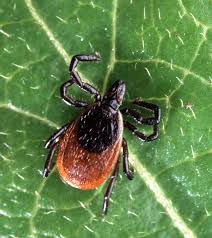Lyme disease
- Nutrexcellence
- May 9, 2018
- 3 min read
Updated: Oct 9, 2021
Over 30,000 cases of Lyme disease are reported in the United States every year
This disease takes its name from the town of Old Lyme, Connecticut, where it was first identified in 1975. Since that time, the locations and the number of cases of Lyme disease have continued to increase. Over 30,000 cases of Lyme disease are reported in the United States every year, according to the CDC. Approximately 90% of confirmed Lyme disease cases were reported from 14 states: Connecticut, Delaware, Maine, Maryland, Massachusetts, Minnesota, New Hampshire, New Jersey, New York, Pennsylvania, Rhode Island, Vermont, Virginia and Wisconsin. It also occurs in Europe, Russia, China, Japan and Australia.
Lyme disease is the most common tick-borne illness in the United States

The bacteria, spirochetes called Borrelia burgdorferi, are transmitted by the deer tick (carried by deer and mice). Deer ticks are very tiny; an adult tick is less than one-tenth of an inch long, and the nymph is the size of a pinhead. Because they are so tiny, they often go undetected. People most likely to be affected are people who spend time outdoors in or near wooded areas, where ticks are prevalent, and the majority of cases occur in the summer and fall.
After a tick bites, it waits several hours before it begins to feed on the host’s blood, and once it does, it feasts for three or four days. As it feeds, it may deposit its infectious bacteria in the host’s bloodstream.
Symptoms of Lyme Disease

The symptoms of Lyme disease are extremely variable which may take anywhere from two to thirty-two days. The first sign may be the appearance of a red, circular lesion or rash on the skin, which is known as erythema migrans (EM). This is caused by the migration of the infecting organism outward through the skin, and it may appear anywhere from a few days to a few weeks after the bite. The lesion gradually expands in a circular pattern, while the center appears to clear up. For this reason, it is often refered to as a bull’s-eye rash. In addition to the rash (or, in some cases, instead of the rash), achiness, backache, difficulty sleeping, fatigue, flu like symptoms, headache, muscle weakness, stiff neck, and, occasionally, nausea and vomiting may occur.
Lyme disease is treatable and almost always curable if found in its early stages. If the disease is not treated in the early stages; however, arthritis, enlargement of the spleen and lymph nodes, eye inflammation, hepatitis, irregular heart rhythm and damage to the cardiovascular and central nervous systems can occur. Some people find that their symptoms slowly subside over two to three years; others develop chronic problems. Often, symptoms leave and recur without another tick bite.
A simple test has been developed to identify Lyme disease. A blood sample is used to measure the levels of certain antibodies that usually increase in number from three days to three weeks after infection.
Recommendations

Include plenty of garlic in your diet. It is a natural antibiotic and immune-booster.
When spending time in or near wooded areas, wear long pants and tuck them into your socks. Wear a long-sleeved shirt with a high neck or a scarf, plus a hat and gloves. Wear light-colored clothing so that any ticks will be more visible.
Use insect repellent on your clothing, your neck and any other exposed area except your face. Using essential oils is a great natural way to repel ticks. The essential oils most commonly used as tick repellents include eucalyptus, lavender, lemongrass, lemon, geranium, palmarosa, pennyroyal and cedarwood. Add drops to a spray bottle containing water, apple cider vinegar/vodka and witch hazel. Do not spray essential oils directly on the skin. Spray on clothing.
After spending time outdoors, check yourself carefully for any small raised bumps and for pinpoint-sized specks on clothing. Do this right away; the longer a tick is attached, the greater the risk of Lyme disease.
Dry your laundry in an electric clothes dryer for half an hour to kill any ticks that may be present. Washing clothes, even in hot water and bleach, will not necessarily kill ticks.
Inspect pets before letting them indoors. They may carry ticks into the house that can fall off and bite family members.
In a wooded or overgrown area, try to stay near the centers of trails and out of wooded areas, especially in May, June, and July.
Keep your lawn mowed and remove leaf litter and brush. Move woodpiles away from the house during the summer.
“The nutritional suggestions in this material are not offered to treat, mitigate or cure disease, and should not be used as a substitute for sound medical advice. This information is designed to be used in conjunction with the services of a trained, licensed healthcare practitioner.”









Comments